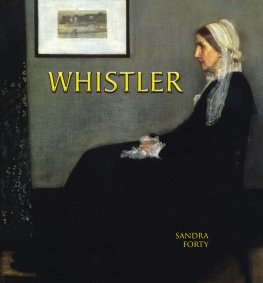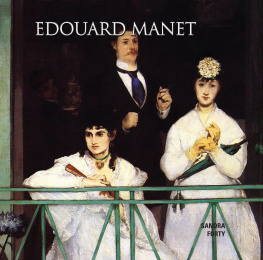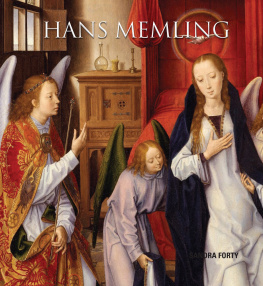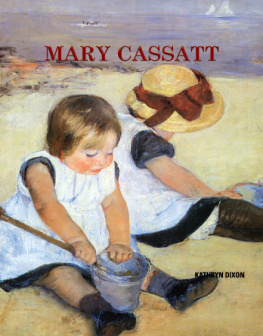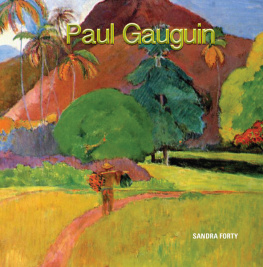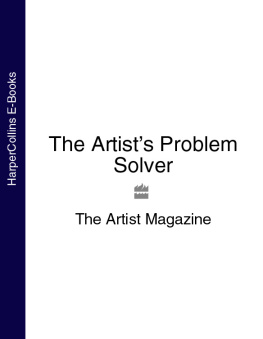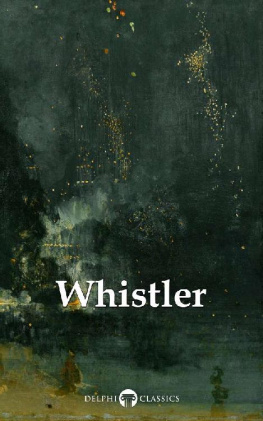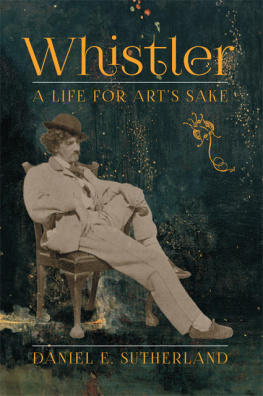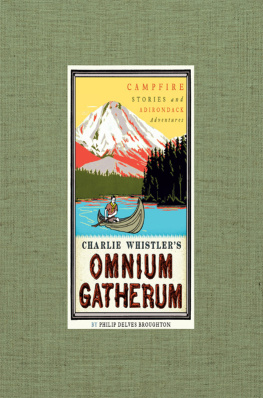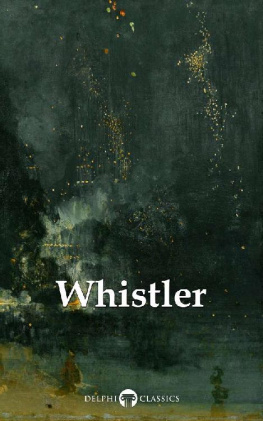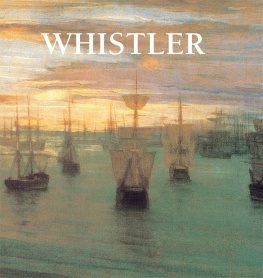
Published by TAJ Books International LLC 2014
5501 Kincross Lane
Charlotte, North Carolina, USA
28277
www.tajbooks.com
www.tajminibooks.com
Copyright 2014 TAJ Books International LLC
All rights reserved. No part of this publication may be reproduced, stored in a retrieval system, or transmitted in any form or by any means, electronic, mechanical, photocopying, recording, or otherwise, without the prior written permission of the Publisher and copyright holders.
All notations of errors or omissions (author inquiries, permissions) concerning the content of this book should be addressed to .
The Publisher thanks The Hunterian Museum and Art Gallery, University of Glasgow, Scotland.
ISBN 978-1-84406-253-9
Printed in China
1 2 3 4 5 18 17 16 15 14

JAMES MACNEILL WHISTLER
18341903
J ames McNeill Whistlers guiding principle was art for arts sake. He never bent in his belief that an artist should only work to please himself and not pander to public opinion. Furthermore, he believed that if nature did not present itself harmoniously, he was completely within his rights to improve it.
Whistler lived his life in a swirl of controversy over his art and his often self-aggrandizing behavior, which tainted his associations with fellow artists and the public. He endured periods of poverty and enjoyed times of plenty as his fortunes failed or prospered. Whistler enjoyed shocking both friends and strangers with his often biting wit and dandyish appearance; he even affected a monocle. For a long period he was friendly with Oscar Wildethey were both regularly caricatured in Punchuntil they inevitably fell out and Wilde satirized Whistler as the murdered artist in his novel The Picture of Dorian Gray.
Many of Whistlers later paintings were portraits, and he was a demanding artist who required long and numerous sittings from his models. His technique was rapid, but his process slow and painstaking, often rubbing out and reworking pieces he was not satisfied with. Starting with a blank canvas he would lightly sketch out his composition and then in numerous layers of thin paint gradually build up the tonal quality from an initial gray-brown wash into the final composition. The process could take months as he gradually consolidated the work. One of his sitters, Arthur J. Eddy, described the process in 1894 being as if the portrait were hidden within the canvas and the master by passing his wands day after day over the surface evoked the image.
Whistlers tonally disciplined palette distinguishes his painting from all other artists and provides his work with a sophistication and elegance unlike that of any other artist. He became a leader in the Aesthetic Movement and frequently wrote and lectured about his ideas on art and philosophy. Not always popular with his contemporaries, toward the end of his career Whistler was greatly revered by the younger generation of artists who appreciated his often austere style.
Many of Whistlers paintings build up into studies in black, in concurrence with his belief that black is the most important element for tonal harmony. His most famous painting, Arrangement in Gray and Black, No 1 (better known as Whistlers Mother), fully displays his painting philosophy that tone and composition were more important than the prevalent Victorian sentimental preoccupation with creating an accurate likeness of the sitter and imbuing the entire composition with sentiment.
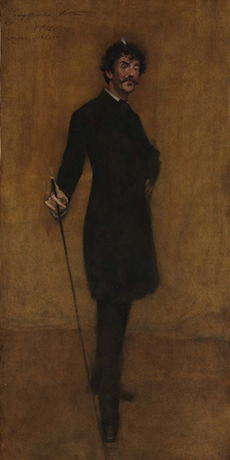
A portrait of Whistler by William Merritt Chase, 1885, The Metropolitan Museum of Art, New York City
Another regular theme was the landscape, especially nocturnes, which implied nonspecific but romantic nighttime scenes. Indeed, Whistler often gave his works generalized titles in order to emphasize his belief in the importance of line over color, composition over content. To continue the musical metaphor, Whistler liked to give his paintings titles such as symphonies, harmonies, compositions, and arrangements. A major art critic, John Ruskin, was appalled by Whistlers work and in an 1877 review of Nocturne in Black and Gold: The Falling Rocket accused the artist of among other things flinging a pot of paint in the publics face. The painting was a dark and smokey scene of gold-speckled fireworks over Battersea Bridge, London, and Whistler responded with a writ for libel. A year would pass before a court settlement was reached in which Whistler won a pyrrhic victory; he was awarded a farthing in damages and had to share the court costs with Ruskin. This episode helped bring about his financial ruin and subsequent bankruptcy.
In the mid-19th century, Japanese porcelain and prints were seen for the first time in the West and greatly admired by contemporary artists for their flat color and unusual composition angles. Whistler was no exception, and by the 1860s he was clearly using Japanese-inspired spatial arrangements, angles, and organization in his works. Around this time too Whistler started to develop his butterfly signature. He came up with the idea after studying the stylized signature marks that Japanese artists applied to their works. His first design was composed of his initials JW arranged like a butterflys wings. Whistler consciously used his monogram as a decorative motif to balance his compositions and sometimes placed it on the picture frame when it was part of the overall decoration. Over the next 30 years, he refined his monogram. In 1877 during his legal tussle with Ruskin, he added a scorpion stinger to its tail, and 10 years later when he married Beatrix Godwin he included a trefoil for luck.
Although American by birth and heritage, James Whistler spent most of his life in western Europe, particularly in Paris and London. He was bom James Abbott Whistler (McNeill was added much later) on July 11, 1834, in Lowell, Massachusetts. His religiously observant mother, Anna Matilda McNeill, was the second wife of George Washington Whistler, a leading civil railroad engineer whose work took him to St. Petersburg, Russia, in August 1843. When Whistler was nine, the rest of the family joined George in Russia. Whistler traveled to St. Petersburg with his older half-brother and half-sister, George and Deborah, and younger brothers, William and Charles (who tragically died en route).
The family lived near The Hermitage and all the children received a multi-lingual education. From an early age, Whistler was drawing at every opportunity but he was easily bored and irritable so to distract him his parents decided to get him private art lessons from Alexander Karetzky, an advanced art student. Then, in 1845 at age 11, he was enrolled at the Imperial Academy of Fine Arts in St. Petersburg where the lessons were in French and Russian and he copied classical sculptures three times a week. In March 1846 he achieved top grades, especially in anatomy, and graduated 28th out of 100 students.
The bitterly cold Russian winters caused Whistler to suffer from recurring bouts of rheumatic fever and in 1847 he was confined to bed for six weeks. During this time his sister, Deborah, brought him a book of Hogarth engravings that ignited his life-long love and admiration for the artist.
Two years later during a visit to London, Deborahs new husband, the noted physician Seymour Haden, took Whistler around the studios and galleries where he listened to art lectures and met other creative people. He discovered photography and became increasingly enthused by the entire art world and began to see his own future as an artist, writing to his father in Russia to tell him so. Sadly, his father died of cholera soon afterward so his mother took the family back to her home town of Pomfret, Connecticut.
Next page
